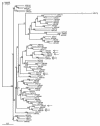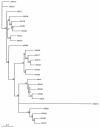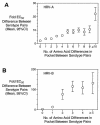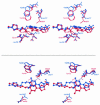VP1 sequencing of all human rhinovirus serotypes: insights into genus phylogeny and susceptibility to antiviral capsid-binding compounds
- PMID: 15016887
- PMCID: PMC371056
- DOI: 10.1128/jvi.78.7.3663-3674.2004
VP1 sequencing of all human rhinovirus serotypes: insights into genus phylogeny and susceptibility to antiviral capsid-binding compounds
Abstract
Rhinoviruses are the most common infectious agents of humans. They are the principal etiologic agents of afebrile viral upper-respiratory-tract infections (the common cold). Human rhinoviruses (HRVs) comprise a genus within the family Picornaviridae. There are >100 serotypically distinct members of this genus. In order to better understand their phylogenetic relationship, the nucleotide sequence for the major surface protein of the virus capsid, VP1, was determined for all known HRV serotypes and one untyped isolate (HRV-Hanks). Phylogenetic analysis of deduced amino acid sequence data support previous studies subdividing the genus into two species containing all but one HRV serotype (HRV-87). Seventy-five HRV serotypes and HRV-Hanks belong to species HRV-A, and twenty-five HRV serotypes belong to species HRV-B. Located within VP1 is a hydrophobic pocket into which small-molecule antiviral compounds such as pleconaril bind and inhibit functions associated with the virus capsid. Analyses of the amino acids that constitute this pocket indicate that the sequence correlates strongly with virus susceptibility to pleconaril inhibition. Further, amino acid changes observed in reduced susceptibility variant viruses recovered from patients enrolled in clinical trials with pleconaril were distinct from those that confer natural phenotypic resistance to the drug. These observations suggest that it is possible to differentiate rhinoviruses naturally resistant to capsid function inhibitors from those that emerge from susceptible virus populations as a result of antiviral drug selection pressure based on sequence analysis of the drug-binding pocket.
Figures






References
-
- Arnold, E., and M. G. Rossmann. 1990. Analysis of the structure of a common cold virus, human rhinovirus 14, refined at a resolution of 3.0 Å. J. Mol. Biol. 211:763-801. - PubMed
-
- Bertino, J. S. 2002. Cost burden of viral respiratory infections: issues for formulary decision makers. Am. J. Med. 112:42S-49S. - PubMed
MeSH terms
Substances
LinkOut - more resources
Full Text Sources
Other Literature Sources

